Our last blog was a bit after the fact because we ran out of data on our Turkish SIM card, just at publishing time. It took three more stops until we were able to find a Turkcell dealer and top up our minutes. In the interim, the blog was published without photos using wifi from a bar. The photos have since been added so, in case you have’t already seen them, please do check our previous blog out again.

We left Bozburun and went west along the southern coast of the Datca peninsula. However, we only spent one night in Datça because stronger winds were forecast over the next day or two and it wasn’t the best of anchorages. Paul, our Swiss friend, suggested Pamalut as a good place to be when the Meltemi picks up. It has a small harbor, about 10 n. miles from Datça, but can pack in quite a lot of boats Med moored. We were lucky to get in early so were directed to a berth with lazy lines (to a heavy mooring chain running along the bottom, the length of the harbor) and our stern lines to the dock. Sure enough, the wind picked up to over 25 knots shortly before midnight, but we felt quite secure. It may have been one of the hottest winds we have yet encountered! As has been the case wherever we are in Turkey, we enjoyed the welcome we encountered in the bars, restaurants, and stalls (freshly cracked almonds) and the laid back feel of Pamalut, a small Turkish holiday destination with an island opposite it and a couple of beaches either side of the harbour.

Our next stop was Knidos, only 8 n.m away, at the extremity of the Datça peninsula. More motoring to get there due to the usual head winds going west at this time of year. However, it was a wonderful stop in an ancient port that has been prized for its strategic location and natural protection from the prevailing winds for many millenia. Although quite crowded, we managed to anchor with boats all around us and then take a welcome dip in the crystal clear water to cool off. Fortunately it was a calm night so we had no issues but they say it can get exciting when the wind picks up there! The next morning we explored some of the extensive ancient ruins before heading on our way towards Bodrum.
Knidos dates back to the 13th century BC. It was famous in ancient times for its amphitheaters and the Temple of Aphrodite, which housed a nude statue of Aphrodite. The Doric Greeks established the city. It fell to the Persian empire in 478 BC and became allied to Sparta in 412 BC. It had two harbors, one for warships and the other for merchant ships. Knidos was the birthplace of Eudoxus, a famous mathematician and philosopher; Praxiteles, who sculpted Aphrodite; and Sostratos, the architect of the lighthouse in Alexandria. It also had a medical school.
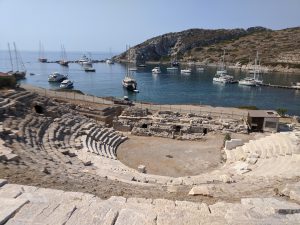


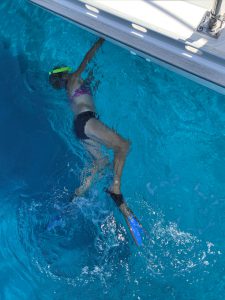
The forecast was for light winds so it was no surprise that we set off motoring around the headland and beyond. In theory we should have set a bit of a zigzag course to avoid Greek waters but, having witnessed Greek ferries in Turkish waters and observed Turkish boats traversing Greek waters, we decided to take the most direct route (a straight line) towards Bodrum. It was a bonus when we encountered 18-20 knot winds on the beam after passing Kos and enjoyed perhaps one of our fastest trips to date this year. We anchored in the bay, Kale Koyu, to the east of the castle and Bodrum marina and have enjoyed 3 comfortable nights here so far, feeling that our anchor is securely dug in.
The castle, with its four towers named after the countries responsible for their construction English, French, German, and Italian, was built from 1402 onwards, but was taken over by the Ottoman Empire in 1523. In the early 1960’s it was used to house an underwater archaeological museum, supposedly one of the best in the Med. Unfortunately, it was closed for renovation.
Bodrum normally hosts many tourists during the summer, including Russian oligarchs, and the bay and marina are packed with boasts, large and small. This year there are very few non-Turkish tourists present; very tough on the restaurants and shops.
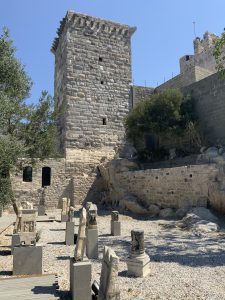
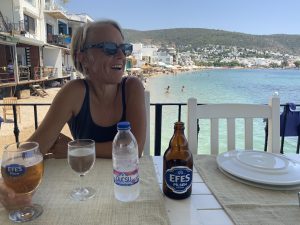
Greece is still not open to boats from Turkey, so we are staying in Turkey. However, two boats from Finike have made the 700+ mile trip to Malta, with the hope that they can enter Greek waters from there.
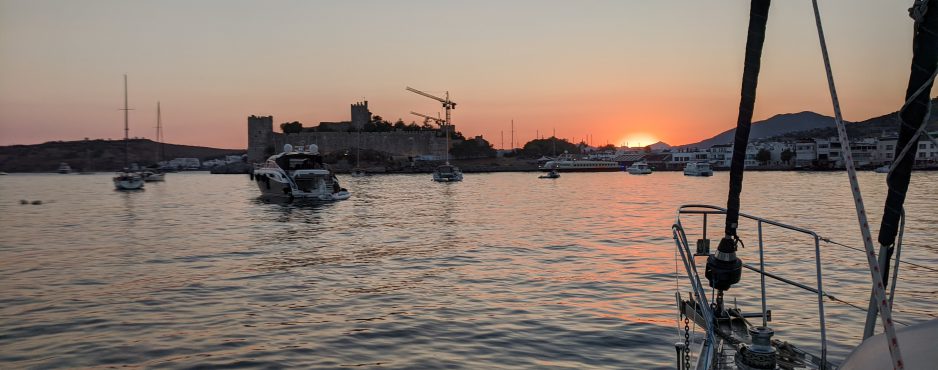
3 Comments
Cheryll
Well we made it to Lymington this weekend and it was probably 30degrees- not that we are competing!! Realise must share your blog with Julian as he has sailed many of those Turkish grounds. Hope we get there one day. Shame about Greece but it’s probably making you slow down which is never bad. In my view the food is better in Turkey too. Enjoy!!
Ruth and Nick Pearman
By gum more tough days as we can see from the photos as you grit your teeth, grin and bear it in this amazing part of the world.
Here in good old Blighty we are up in the mid 30’s, eating in the garden, feasting on home grown tomatoes and runner beans!
Ruth and Nick Pearman
Love reading your blog as you discover more of Turkey, and especially when it involves places we know. We were able to visit the archeological museum in Bodrum Castle and it was fascinating. But then so is all the rest. Carry on cruising!